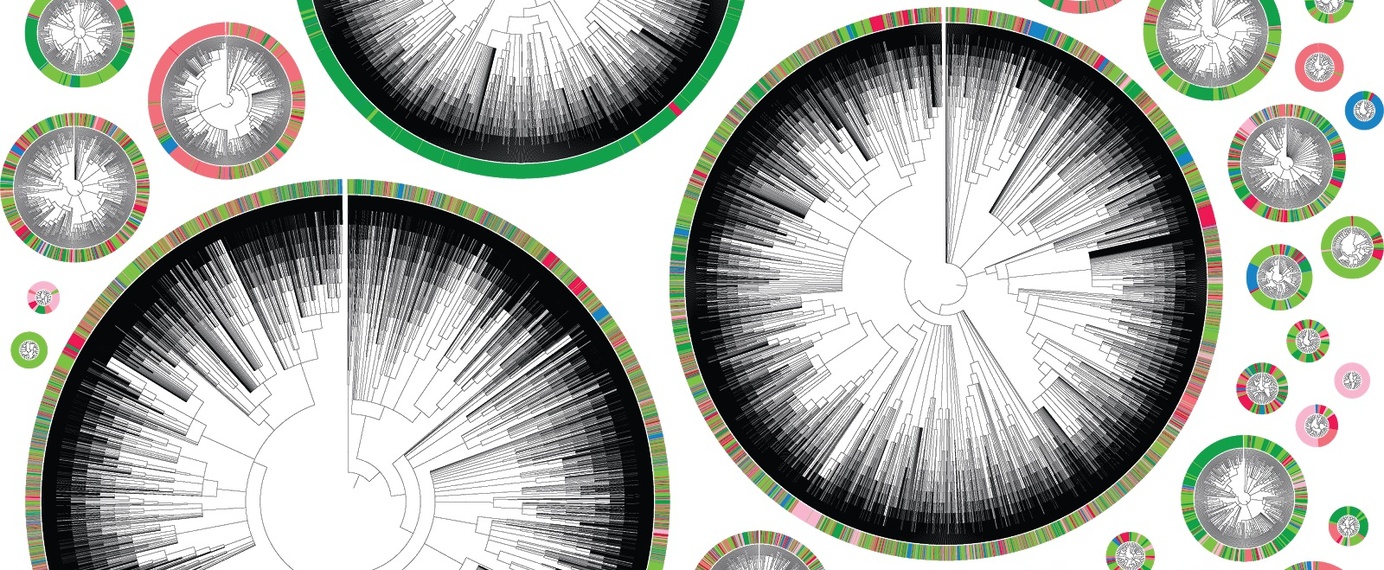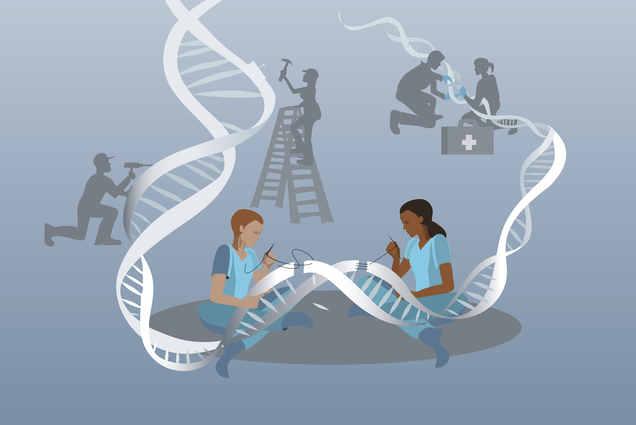Tool Development
As our researchers seek to answer novel questions about fundamental biology, health, and disease, sometimes they find that the tools needed to answer those questions do not exist. In these cases, they must invent new tools–or tailor existing tools–in order to make new discoveries.

Phylogenetic trees starting with an individual cancer cell. Each color represents a different location in the body. A very colorful tree shows a highly metastatic phenotype, where a cell’s descendants jumped many times between different tissues. A tree that is primarily one color represents a less metastatic cell.
Jeffrey Quinn/Whitehead Institute
When Whitehead Institute researchers find that there are no tools available to answer an ambitious research question, they do not let that problem stop them; instead, they invent the tools they need and carry on in pursuit of scientific discovery. Our researchers build experimental and computational tools, and make use of a variety of cell and animal models. Some of these tools provide new ways of analyzing data to identify obscure patterns; others enable researchers to see things that were previously invisible to them; and some new technologies may one day provide the basis for innovative medical therapies.

Jennifer Cook-Chrysos/Whitehead Institute
Machine learning models, neural networks, and artificial intelligence allow for analyses of unprecedented scale and complexity. Our researchers create new models and tailor existing algorithms in order to find the signal amongst the noise, and identify what is significant in massive or sparse datasets. These tools can provide new insights into health and disease, such as where in the cell drugs concentrate and how efficiently they interact with their desired targets; which signals a given cell responds to and which signals will turn a stem cell into a desired cell type; how different types of brain cells communicate; and what are the early diagnostic signs of complex diseases such as Alzheimer’s that could allow for early interventions.

Jennifer Cook-Chrysos/Whitehead Institute
Our researchers routinely use gene editing techniques, including CRISPR/Cas9 based approaches, to learn more about genes and gene regulation. They have also developed CRISPR-based epigenetic edit tools, which silence genes without having to edit the underlying DNA sequence, that can activate or deactivate genes. Several of these tools are being developed into potential medical therapies that could silence disease genes in diseases including neurodevelopmental disorder Rett Syndrome and fatal prion diseases. Additionally, our researchers have developed barcoding and lineage-tracing approaches that allow them to track cells through generations of cell divisions with exceptional detail and build family trees; they have used these tools to understand the evolution of cancer cells, paths that metastatic cancers take through the body, what genes confer fitness to parasites in live hosts, and more.

Top left: Rebecca Povilus/ Whitehead Institute, top right: Kathleen Mazza-Curll/Mansi Srivastava/Whitehead Institute, bottom right: "Arabidopsis thaliana 2019-04-27 2246" by Salicyna is licensed under CC BY-SA 4.0, bottom left: Gerald Fink/ Whitehead Institute
Researchers must identify or develop accurate models of human biology in order to study questions in the lab in systems that reflect what happens inside of the human body. Our researchers use a variety of animal models, making the most of each species’ unique traits–and their similarities to humans–to learn about topics including development and regeneration, sex differences, infectious disease, and more. Sometimes our researchers help to establish new animal models, figuring out how to effectively rear animals for study and designing protocols and genetic tools tailored to those animals. Our researchers use stem cells to create accurate models of human cell types and tissues, including by using 3D organoids. They are improving stem cell models by making stem-cell-derived cells more closely match cells taken directly from the body. Sometimes, our researchers combine approaches, putting human cells in animal models in order to study human biology in a living system.


